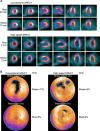Recent trends in nuclear cardiology practice
- PMID: 24010067
- PMCID: PMC3759683
- DOI: 10.4068/cmj.2013.49.2.55
Recent trends in nuclear cardiology practice
Abstract
Over the past three decades, radionuclide myocardial perfusion scintigraphy (MPS) has become established as the main functional cardiac imaging technique for ischemic heart disease. It is currently appropriate for all aspects of detecting and managing ischemic heart disease, including diagnosis, risk assessment and stratification, assessment of myocardial viability, and evaluation of left ventricular function. The purpose of this article was to review recent trends in nuclear cardiology practice, excluding positron emission tomography. The past few years have brought several rapid developments that have increased photon sensitivity in nuclear cardiology scanner hardware. Additionally, software applying new methods of single photon emission tomography (SPECT) reconstruction on conventional and dedicated systems has preserved or even improved SPECT image quality with lower count statistics. On the other hand, much interest has been shown in lowering the radiation dose by the stakeholders of MPS.
Keywords: Myocardial perfusion imaging; Radiation; SPECT.
Figures



Similar articles
-
Single photon emission computed tomography for the diagnosis of coronary artery disease: an evidence-based analysis.Ont Health Technol Assess Ser. 2010;10(8):1-64. Epub 2010 Jun 1. Ont Health Technol Assess Ser. 2010. PMID: 23074411 Free PMC article.
-
Positron emission tomography for the assessment of myocardial viability: an evidence-based analysis.Ont Health Technol Assess Ser. 2005;5(16):1-167. Epub 2005 Oct 1. Ont Health Technol Assess Ser. 2005. PMID: 23074467 Free PMC article.
-
Recent Advances in Nuclear Cardiology.Nucl Med Mol Imaging. 2016 Sep;50(3):196-206. doi: 10.1007/s13139-016-0433-x. Epub 2016 Jul 13. Nucl Med Mol Imaging. 2016. PMID: 27540423 Free PMC article. Review.
-
High-Sensitivity and High-Resolution SPECT/CT Systems Provide Substantial Dose Reduction Without Compromising Quantitative Precision for Assessment of Myocardial Perfusion and Function.J Nucl Med. 2016 Jun;57(6):893-9. doi: 10.2967/jnumed.115.164632. Epub 2016 Feb 4. J Nucl Med. 2016. PMID: 26848173
-
New cardiac cameras: single-photon emission CT and PET.Semin Nucl Med. 2014 Jul;44(4):232-51. doi: 10.1053/j.semnuclmed.2014.04.003. Semin Nucl Med. 2014. PMID: 24948149 Review.
Cited by
-
Intranasal delivery of imaging agents to the brain.Theranostics. 2024 Aug 19;14(13):5022-5101. doi: 10.7150/thno.98473. eCollection 2024. Theranostics. 2024. PMID: 39267777 Free PMC article. Review.
References
-
- 2006 image of the year: focus on cardiac SPECT/CT. J Nucl Med. 2006;47:14N–15N. - PubMed
-
- Gambhir SS, Berman DS, Ziffer J, Nagler M, Sandler M, Patton J, et al. A novel high-sensitivity rapid-acquisition single-photon cardiac imaging camera. J Nucl Med. 2009;50:635–643. - PubMed
-
- Garcia EV, Faber TL, Esteves FP. Cardiac dedicated ultrafast SPECT cameras: new designs and clinical implications. J Nucl Med. 2011;52:210–217. - PubMed
-
- Sharir T, Slomka PJ, Hayes SW, DiCarli MF, Ziffer JA, Martin WH, et al. Multicenter trial of high-speed versus conventional single-photon emission computed tomography imaging: quantitative results of myocardial perfusion and left ventricular function. J Am Coll Cardiol. 2010;55:1965–1974. - PubMed
Publication types
LinkOut - more resources
Full Text Sources
Other Literature Sources
Miscellaneous

